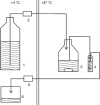The use of in vitro model systems to study dental biofilms associated with caries: a short review
- PMID: 25740099
- PMCID: PMC4349908
- DOI: 10.3402/jom.v7.26149
The use of in vitro model systems to study dental biofilms associated with caries: a short review
Abstract
A dental biofilm forms a distinct environment where microorganisms live in a matrix of extracellular polysaccharides. The biofilm favors certain bacteria and creates a habitat that functions differently compared to planktonic bacteria. Reproducible model systems which help to address various questions related to biofilm formation, the process of caries development, and its prevention are needed and are continuously developed. Recent research using both batch culture, continuous culture and flow cells in caries biofilm formation is presented. The development of new techniques and equipment has led to a deeper understanding of how caries biofilms function. Biofilm models have also been used in the development of materials inhibiting secondary caries. This short review summarizes available models to study these questions.
Keywords: artificial mouth; batch culture; continuous culture; dental caries; flow cell; microcosm.
Figures

Similar articles
-
Protocols to Study Dental Caries In Vitro: Microbial Caries Models.Methods Mol Biol. 2019;1922:357-368. doi: 10.1007/978-1-4939-9012-2_32. Methods Mol Biol. 2019. PMID: 30838590
-
Development of multi-species consortia biofilms of oral bacteria as an enamel and root caries model system.Arch Oral Biol. 2000 Jan;45(1):27-40. doi: 10.1016/s0003-9969(99)00111-9. Arch Oral Biol. 2000. PMID: 10669090
-
Biofilm Models to Study the Etiology and Pathogenesis of Oral Diseases.Monogr Oral Sci. 2021;29:30-37. doi: 10.1159/000510197. Epub 2020 Dec 21. Monogr Oral Sci. 2021. PMID: 33427216 Review.
-
Oral microbial biofilms: an update.Eur J Clin Microbiol Infect Dis. 2019 Nov;38(11):2005-2019. doi: 10.1007/s10096-019-03641-9. Epub 2019 Aug 1. Eur J Clin Microbiol Infect Dis. 2019. PMID: 31372904 Review.
-
Effects of Antimicrobial Peptide GH12 on the Cariogenic Properties and Composition of a Cariogenic Multispecies Biofilm.Appl Environ Microbiol. 2018 Nov 30;84(24):e01423-18. doi: 10.1128/AEM.01423-18. Print 2018 Dec 15. Appl Environ Microbiol. 2018. PMID: 30341079 Free PMC article.
Cited by
-
In Vitro Models Used in the Formation of Root Caries Lesions-A Review of the Literature.Dent J (Basel). 2023 Nov 26;11(12):269. doi: 10.3390/dj11120269. Dent J (Basel). 2023. PMID: 38132407 Free PMC article. Review.
-
Spatiotemporal monitoring of a periodontal multispecies biofilm model: demonstration of prebiotic treatment responses.Appl Environ Microbiol. 2023 Oct 31;89(10):e0108123. doi: 10.1128/aem.01081-23. Epub 2023 Sep 28. Appl Environ Microbiol. 2023. PMID: 37768099 Free PMC article.
-
Effects of Xylitol and Sucrose Mint Products on Streptococcus mutans Colonization in a Dental Simulator Model.Curr Microbiol. 2017 Oct;74(10):1153-1159. doi: 10.1007/s00284-017-1299-6. Epub 2017 Jul 17. Curr Microbiol. 2017. PMID: 28717846 Free PMC article.
-
The potential use of bacteriophages as antibacterial agents in dental infection.Virol J. 2024 Oct 18;21(1):258. doi: 10.1186/s12985-024-02510-y. Virol J. 2024. PMID: 39425223 Free PMC article. Review.
-
Investigation of a novel biofilm model close to the original oral microbiome.Appl Microbiol Biotechnol. 2024 May 10;108(1):330. doi: 10.1007/s00253-024-13149-8. Appl Microbiol Biotechnol. 2024. PMID: 38730049 Free PMC article.
References
-
- Featherstone JD. Modeling the caries-inhibitory effects of dental materials. Dent Mater. 1996;12:194–7. - PubMed
-
- Kutsch VK. Dental caries: an updated medical model of risk assessment. J Prosthet Dent. 2014;111:280–5. - PubMed
-
- Marsh PD. Contemporary perspective on plaque control. Br Dent J. 2012;212:601–6. - PubMed
-
- Blanc V, Isabal S, Sanchez MC, Llama-Palacios A, Herrera D, Sanz M, et al. Characterization and application of a flow system for in vitro multispecies oral biofilm formation. J Periodontal Res. 2014;49:323–32. - PubMed
LinkOut - more resources
Full Text Sources
Other Literature Sources
